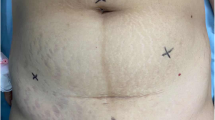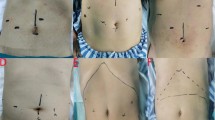Abstract
Purpose
Rectus sheath block (RSB) is an anterior abdominal wall block that reduces postoperative pain associated with midline incisions. This study aims to investigate the effect of ultrasound-guided bilateral RSB (US-BRSB) on postoperative pain and analgesic consumption in patients undergoing laparoscopic gynecologic surgery.
Methods
Sixty patients who underwent laparoscopic gynecologic surgery were allocated to RSB (n = 30) or control (n = 30) group. A bilateral US-BRSB procedure (30 ml of 0.25% ropivacaine) was performed after induction of general anesthesia in the RSB group. The control group proceeded the surgery without sham block. All patients received fentanyl-based intravenous patient-controlled analgesia and rescue analgesics upon demand. Pain was scored by a blinded observer using a verbal numerical rating scale (VNRS) at rest while coughing at 0, 1, 6, 12, 24, and 48 h after postanesthesia care unit (PACU) admission. The primary outcome was the total number of rescue analgesics used in the 48-h postoperative period.
Results
At 0 h, VNRS were lower in the RSB group than in the control, both at rest (median VNRS 4.5 vs. 5, p = 0.02) and while coughing (median VNRS 6 vs. 7, p = 0.004). At 6 h, VNRS scores were lower in the RSB group than in the control while coughing (median VNRS 3 vs. 5, p = 0.01). Fentanyl use as rescue analgesics in the PACU was significantly lower in the RSB group than in the control (27.7 ± 32.1 vs. 53.3 ± 33.7 µg, respectively; p = 0.004). At 48 h postoperatively, the total number of rescue analgesics administered were significantly fewer in the RSB group than in the control (2.5 ± 2.5 vs. 3.9 ± 2.6, respectively; p = 0.04).
Conclusion
US-BRSB reduces the immediate postoperative pain and opioid consumption during the early postoperative period.
ClinicalTrials.gov identifier
NCT02476799, https://clinicaltrials.gov/ct2/show/NCT02476799.




Similar content being viewed by others
References
Smith BE, Suchak M, Siggins D, Challands J. Rectus sheath block for diagnostic laparoscopy. Anaesthesia. 1988;43:947–8.
Willschke H, Bösenberg A, Marhofer P, Johnston S, Kettner SC, Wanzel O, Kapral S. Ultrasonography-guided rectus sheath block in paediatric anaesthesia—a new approach to an old technique. Br J Anaesth. 2006;97:244–9.
Gurnaney HG, Maxwell LG, Kraemer FW, Goebel T, Nance ML, Ganesh A. Prospective randomized observer-blinded study comparing the analgesic efficacy of ultrasound-guided rectus sheath block and local anaesthetic infiltration for umbilical hernia repair. Br J Anaesth. 2011;107:790–5.
Dingeman RS, Barus LM, Chung HK, Clendenin DJ, Lee CS, Tracy S, Johnson VM, Dennett KV, Zurakowski D, Chen C. Ultrasonography-guided bilateral rectus sheath block vs local anesthetic infiltration after pediatric umbilical hernia repair: a prospective randomized clinical trial. JAMA Surg. 2013;148:707–13.
Azemati S, Khosravi MB. An assessment of the value of rectus sheath block for postlaparoscopic pain in gynecologic surgery. J Minim Invasive Gynecol. 2005;12:12–5.
Crosbie EJ, Massiah NS, Achiampong JY, Dolling S, Slade RJ. The surgical rectus sheath block for post-operative analgesia: a modern approach to an established technique. Eur J Obstet Gynecol Reprod Biol. 2012;160:196–200.
Petersen PL, Stjernholm P, Kristiansen VB, Torup H, Hansen EG, Mitchell AU, Moeller A, Rosenberg J, Dahl JB, Mathiesen O. The beneficial effect of transversus abdominis plane block after laparoscopic cholecystectomy in day-case surgery: a randomized clinical trial. Anesth Analg. 2012;115:527–33.
Sandeman DJ, Bennett M, Dilley AV, Perczuk A, Lim S, Kelly KJ. Ultrasound-guided transversus abdominis plane blocks for laparoscopic appendicectomy in children: a prospective randomized trial. Br J Anaesth. 2011;106:882–6.
Ortiz J, Suliburk JW, Wu K, Bailard NS, Mason C, Minard CG, Palvadi RR. Bilateral transversus abdominis plane block does not decrease postoperative pain after laparoscopic cholecystectomy when compared with local anesthetic infiltration of trocar insertion sites. Reg Anesth Pain Med. 2012;37:188–92.
El Hachem L, Small E, Chung P, Moshier EL, Friedman K, Fenske SS, Gretz HF. Randomized controlled double-blind trial of transversus abdominis plane block versus trocar site infiltration in gynecologic laparoscopy. Am J Obstet Gynecol. 2015;212(182):e1–9.
Rozen WM, Tran TMN, Ashton MW, Barrington MJ, Ivanusic JJ, Taylor GI. Refining the course of the thoracolumbar nerves: a new understanding of the innervation of the anterior abdominal wall. Clin Anat (Wiley Subscription Services, Inc., A Wiley Company). 2008;21:325–33.
Bashandy GMN, Elkholy AHH. Reducing postoperative opioid consumption by adding an ultrasound-guided rectus sheath block to multimodal analgesia for abdominal cancer surgery with midline incision. Anesth Pain Med. 2014;4:e18263.
Hamill JK, Liley A, Hill AG. Rectus sheath block for laparoscopic appendicectomy: a randomized clinical trial. ANZ J Surg. 2015;85:951–6.
Ramsay MA. Acute postoperative pain management. Proc (Bayl Univ Med Cent). 2000;13:244–7.
Liu SS, Wu CL. The effect of analgesic technique on postoperative patient-reported outcomes including analgesia: a systematic review. Anesth Analg. 2007;105:789–808.
Xiromeritis P, Kalogiannidis I, Papadopoulos E, Prapas N, Prapas Y. Improved recovery using multimodal perioperative analgesia in minimally invasive myomectomy: a randomised study. Aust N Z J Obstet Gynaecol. 2011;51:301–6.
Nelson G, Altman AD, Nick A, Meyer LA, Ramirez PT, Achtari C, Antrobus J, Huang J, Scott M, Wijk L, Acheson N, Ljungqvist O, Dowdy SC. Guidelines for pre- and intra-operative care in gynecologic/oncology surgery: Enhanced Recovery After Surgery (ERAS®) Society recommendations—part I. Gynecol Oncol. 2016;140:313–22.
Watt DG, McSorley ST, Horgan PG, McMillan DC. Enhanced recovery after surgery: which components, if any, impact on the systemic inflammatory response following colorectal surgery?: A systematic review. Medicine (Baltimore). 2015;94:e1286.
De Kock M. Expanding our horizons: transition of acute postoperative pain to persistent pain and establishment of chronic postsurgical pain services. Anesthesiology. 2009;111:461–3.
Kamei H, Ishibashi N, Nakayama G, Hamada N, Ogata Y, Akagi Y. Ultrasound-guided rectus sheath block for single-incision laparoscopic cholecystectomy. Asian J Endosc Surg. 2015;8:148–52.
Topçu HO, Cavkaytar S, Kokanalı K, Guzel AI, Islimye M, Doganay M. A prospective randomized trial of postoperative pain following different insufflation pressures during gynecologic laparoscopy. Eur J Obstet Gynecol Reprod Biol. 2014;182:81–5.
Smith BE, MacPherson GH, de Jonge M, Griffiths JM. Rectus sheath and mesosalpinx block for laparoscopic sterilization. Anaesthesia. 1991;46:875–7.
Scott JC, Cooke JE, Stanski DR. Electroencephalographic quantitation of opioid effect: comparative pharmacodynamics of fentanyl and sufentanil. Anesthesiology. 1991;74:34–42.
Kim JY, Park SY, Chang HS, Nam SK, Min SK. The efficacy of the time-scheduled decremental continuous infusion of fentanyl for postoperative patient-controlled analgesia after total intravenous anesthesia. Korean J Anesthesiol. 2013;65:544–51.
Author information
Authors and Affiliations
Corresponding author
Ethics declarations
Conflict of interest
The authors report no conflict of interest.
Funding
No source of funding.
Additional information
Paper presentation information: “2014 Seoul International Conference of Anesthesiology in conjunction with the 91st Annual Scientific Meeting of the Korean Society of Anesthesiologists”, Seoul, Korea, November 6–8, 2014.
About this article
Cite this article
Cho, S., Kim, Y.J., Jeong, K. et al. Ultrasound-guided bilateral rectus sheath block reduces early postoperative pain after laparoscopic gynecologic surgery: a randomized study. J Anesth 32, 189–197 (2018). https://doi.org/10.1007/s00540-018-2457-0
Received:
Accepted:
Published:
Issue Date:
DOI: https://doi.org/10.1007/s00540-018-2457-0




